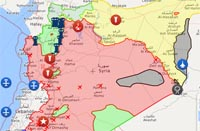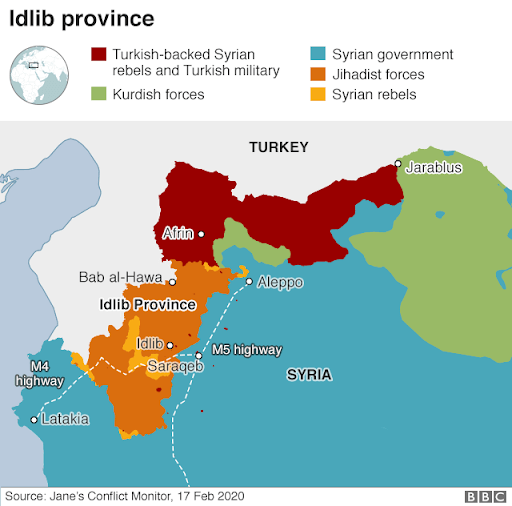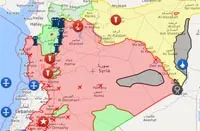Es ist nicht ganz einfach die aktuelle Situation in Syrien zu beschreiben und die politische und militärische Lage richtig einzuschätzen. Seit Beginn des Bürgerkriegs verbreiten die westlichen Medien meistens Lügen und Halbwahrheiten. Ihre Berichte und Kommentare haben ausschließlich das Ziel, Bashar Al-Assad als rücksichtslosen und menschenverachtenden Kriegsverbrecher darzustellen. Das hat sich bis heute nicht geändert. Gebetsmühlenartig werden immer wieder die gleichen Klischees bemüht: Massaker an der Zivilbevölkerung, Fassbomben auf Krankenhäuser,wahllose Folterung und Hinrichtungen von Regimegegnern etc. Die Informationen stammen dabei fast ausschließlich von SOHR in London. Diese vom Westen finanzierte Organisation erhält Berichte von Akteuren vor Ort wie z.B. den “Weisshelmen” und den “Ärzten ohne Grenzen”. Beide sind nicht in ganz Syrien präsent, sondern nur in Gegenden, die von Regimegegnern kontrolliert werden, d.h. nur noch in der Provinz Idlib. Dort arrangieren sie sich mit den unterschiedlichsten Terrorgruppen und Söldnertruppen. Teilweise arbeiten sie mit diesen eng zusammen. Es ist also notwendig andere Quellen zu nutzen. Diese sollen helfen, die militärische Lage und die politische Situation besser einzuschätzen. Außerdem müssen die Hindernisse und Fortschritte beim Wiederaufbau und der Verbesserung der humanitären,wirtschaftlichen und politischen Situation betrachtet werden.Es gibt aber auch einige etablierte westliche Nachrichtensender, die sich um eine objektive Darstellung der Lage bemühen, so u.a. BBC news. Dort hatte ich auch die sehr aufschlussreiche und umfangreiche Darstellung der vom Westen organisierten Flucht der Jihadisten aus Mosul durch einen gesicherten Fluchtkorridor nach Syrien gefunden und in meiner Dokumentation „Uncle Sam rettet die Welt“ abgebildet. Deshalb stelle ich den folgenden Artikel von BBC an den Anfang.
| Die den Krieg entscheidende Schlacht wird in der Provinz Idlib geschlagen. |
| Idlib had been controlled by a number of rival factions, rather than a single group, since it fell to the opposition in 2015. But the dominant force is the al-Qaeda-linked jihadist alliance, Hayat Tahrir al-Sham (HTS).HTS was set up in 2017 by a group that broke off formal ties with al-Qaeda. It is designated as a terrorist organisation by the UN.In January 2019, HTS staged a violent takeover of large areas of the province. It expelled some rebel fighters to Aleppo’s Afrin region, which is controlled by factions supported by Turkey.A UN committee estimated in January that the group had between 12,000 and 15,000 fighters in Idlib and its surrounding areas.In the battle against the government offensive it is supported by a variety of forces – including Chinese Uighur militants, a new al-Qaeda affiliate and Islamist groups fighting under the banner of the Turkey-backed Syrian National Army (SNA)The Islamic State group (IS) has several hundred fighters in Idlib. But other factions actively oppose its presence. |
| Syria war: Why does the battle for Idlib matter?Published on 18 February 2020 A humanitarian catastrophe is unfolding in north-western Syria, where the government of President Bashar al-Assad is trying to recapture the opposition-held province of Idlib.Government air strikes and ground operations have driven almost a million civilians from their homes since December – the biggest single displacement of Syria’s nine-year war.The UN has said a full-scale battle for Idlib could result in a „bloodbath“.What’s so important about Idlib?The province – along with parts of Hama, Latakia and Aleppo – is the last stronghold of the rebel and jihadist groups that have been trying to overthrow President Assad since 2011.The opposition once controlled large parts of the country, but the Syrian army has retaken most of the territory over the past five years with the help of Russian air power and Iran-backed militiamen. Now, the army wants to „liberate“ Idlib.In recent years an influx of desperate displaced people has doubled its population to about three million, including one million children.Idlib is also strategically important to the government. It borders Turkey to the north and straddles highways running south from the city of Aleppo to the capital Damascus, and west to the Mediterranean city of Latakia.Who controls the province?Idlib had been controlled by a number of rival factions, rather than a single group, since it fell to the opposition in 2015. But the dominant force is the al-Qaeda-linked jihadist alliance, Hayat Tahrir al-Sham (HTS).HTS was set up in 2017 by a group that broke off formal ties with al-Qaeda. It is designated as a terrorist organisation by the UN.In January 2019, HTS staged a violent takeover of large areas of the province. It expelled some rebel fighters to Aleppo’s Afrin region, which is controlled by factions supported by Turkey. A UN committee estimated in January that the group had between 12,000 and 15,000 fighters in Idlib and its surrounding areas.In the battle against the government offensive it is supported by a variety of forces – including Chinese Uighur militants, a new al-Qaeda affiliate and Islamist groups fighting under the banner of the Turkey-backed Syrian National Army.The Islamic State group (IS) has several hundred fighters in Idlib. But other factions actively oppose its presence.What led to the current government offensive?Idlib has been subject to a „de-escalation“ agreement between Turkey, Russia and Iran since May 2017. It called for the cessation of hostilities in four opposition strongholds, including Idlib, the „separation“ of jihadists and mainstream rebels inside them, and unhindered aid deliveries.That October, Turkey deployed troops to observation posts on the opposition-held side of the front line in Idlib to monitor the agreement. Russian troops did the same on the government side. However, their presence did not stop the Syrian army retaking a large part of eastern Idlib’s countryside over the next four months.The government then turned its attention to opposition bastions further south – notably Homs province, and the Eastern Ghouta near the capital Damascus.All those were recaptured by July 2018, devastating residential areas, killing hundreds of civilians, and displaced hundreds of thousands. Many opposition supporters were „evacuated“ to Idlib as part of negotiated surrenders.Troops then began preparing for an all-out assault on Idlib. But one was averted in September 2018 by an agreement between Turkey and Russia.The Sochi accord called for a „demilitarised buffer zone“ along the front line. Mainstream rebels were required to pull their heavy weapons out of the zone, and jihadists were told to withdraw altogether.However, it was never fully implemented. Rebels reportedly withdrew some heavy weapons, but the jihadists stayed.Hayat Tahrir al-Sham’s takeover of Idlib a year ago was followed by renewed fighting. Government and Russian warplanes stepped up strikes on opposition-held areas, while jihadists shelled government-held territory.In April 2019, the army launched what Russia called a „limited“ offensive in northern Hama and southern Idlib. The UN said 500 civilians were killed and 400,000 displaced over the next four months before a ceasefire was declared.A further 900,000 civilians – the vast majority of them women and children – have fled since the current government assault began in December, according to the UN. Some 300,000 have been displaced in February alone.The Syrian army has recaptured major towns in southern Idlib and regained control over the Aleppo-Latakia (M4) and Aleppo-Damascus (M5) highways. Those displaced have meanwhile moved north and west to the ever-shrinking space considered safe near the Turkish border.Turkey, which already hosts 3.6 million Syrian refugees and is worried about another influx, has given the Syrian army until the end of February to withdraw behind the line of Turkish observation posts or face military action.Turkey has already sent thousands of reinforcements to Idlib and there have been deadly clashes between Syrian and Turkish forces. But President Assad has vowed to continue the offensive to bring the opposition enclave back under his control.What is happening to the civilians?UN Emergency Relief Co-ordinator Mark Lowcock warned that the crisis in north-western Syria had „reached a horrifying new level“.“[The displaced civilians] are traumatised and forced to sleep outside in freezing temperatures because camps are full. Babies and small children are dying because of the cold,“ he said.Mr Lowcock described the violence as „indiscriminate“, with health facilities, schools, mosques and markets being hit. „Humanitarian workers themselves are being displaced and killed,“ he added.The UN is calling urgently for tents, thermal blankets and clothing, as well as specialist counselling to help deal with trauma.Mr Lowcock said „the biggest humanitarian horror story of the 21st Century“ would only be avoided if those countries with influence in Syria brokered a ceasefire.Last year, he warned that an all-out assault on Idlib could result in „the loss of huge numbers of people – running into hundreds of thousands, possible even more“. |
| Die Rückeroberung der Provinz Idlib, der letzten Rebellenhochburg, durch Assads SAA ist eine entscheidende Voraussetzung für die Beendigung des syrischen Bürgerkriegs. |
| Das ist nur eine Frage der Zeit. Ein Sieg der Regierungstruppen nur über die Syria National Army (SNA) wäre sicher schnell und mit weniger Blutvergießen vonstatten gegangen. Die SNA war von Beginn an nichts weiter als ein zusammengewürfelter Haufen von Deserteuren der Syrian Arab Army (SAA) ohne einheitliche Kommandostrukturen und ohne eine zentrale Führung, so dass der Begriff “Armee” eigentlich nicht zutreffend ist. Auch wenn man ihre Motive zur Rebellion gegen das Regime nachvollziehen kann, so sind sie heute nur noch Komplizen der verschiedenen jihadistischen Terror Gruppen, mit denen sie in der Provinz Idlib eine unheilige Allianz bilden. Die Vertreibung oder Vernichtung der Jihadisten muss das oberste Ziel Assads sein. Von diesen geht für die Alawiten die größte Gefahr aus. Syrien in der Hand von Jihadisten würde ein Massaker unter den Alawiten und Drusen zur Folge haben. Für Assad geht es also nicht nur um den Machterhalt, sondern auch und insbesondere um das Überleben der alawitischen Minderheit. Es ist also eine existentielle Notwendigkeit für Assad unnachgiebig, zielgerichtet, ausdauernd und koste es was es wolle ganz Syrien wieder unter seine Kontrolle zu bringen. Als legitimer, wenn auch nicht demokratisch gewählter, Präsident erhält er die Unterstützung befreundeter Staaten. Russland und der Iran sind nicht erst seit Beginn des Krieges wichtige Verbündete. Die USA und die Türkei dagegen sind Besatzer, die keine Legitimation für ihre Aggression und Besatzung haben. Beide Mächte verfolgen unterschiedliche Interessen. Die USA haben noch immer die Absicht, Assad zu eliminieren. Bashir Al-Assad würde also dasselbe Schicksal drohen, wie Hussein und Gaddafi. |
Liveamap Interaktive aktuelle Karte des Krieges in Syrien.


Syria war: Why does the battle for Idlib matter? Published on 18 February 2020

| The province – along with parts of Hama, Latakia and Aleppo – is the last stronghold of the rebel and jihadist groups that have been trying to overthrow President Assad since 2011. The opposition once controlled large parts of the country, but the Syrian army has retaken most of the territory over the past five years with the help of Russian air power and Iran-backed militiamen. Now, the army wants to „liberate“ Idlib Who controls the province? |
Idlib had been controlled by a number of rival factions, rather than a single group, since it fell to the opposition in 2015. But the dominant force is the al-Qaeda-linked jihadist alliance, Hayat Tahrir al-Sham (HTS).
HTS was set up in 2017 by a group that broke off formal ties with al-Qaeda. It is designated as a terrorist organisation by the UN.
Trump hätte Assad „lieber ausgeschaltet“ Spiegel online 16.09.2020,

US-Präsident Trump behauptet, er habe den syrischen Diktator Assad vor drei Jahren eliminieren wollen – doch sein damaliger Verteidigungsminister sei dagegen gewesen.
Im Jahr 2017 war US-Präsident Donald Trump nach eigenen Angaben kurz davor, einen Militärschlag gegen den syrischen Machthaber Baschar al-Assad anzuordnen. Lediglich sein damaliger Verteidigungsminister James Mattis habe sich diesem Vorhaben widersetzt, sagte Trump dem Sender Fox News.
„Ich hätte ihn lieber ausgeschaltet. Ich hatte ihn schon so weit“, sagte der US-Präsident über Assad. „Aber Mattis wollte es nicht tun.“ Im gleichen Atemzug bewertete er seinen früheren Verteidigungsminister in der Sendung „Fox & Friends“ als „höchst überbewerteten General“.
Trump sur l’«élimination» d’Assad : Damas dénonce un «État voyou»
Mis à jour le 16 septembre 2020

Le président américain a affirmé mardi dernier d’avoir envisagé d’«éliminer» Bachar al-Assad. KEVIN LAMARQUE / REUTERS
La Syrie a fustigé mercredi le président américain Donald Trump qui a dit avoir envisagé d’«éliminer» le chef d’État syrien Bachar al-Assad, qualifiant les États-Unis d’État «voyou et hors-la-loi», selon l’agence de presse officielle Sana.
À LIRE AUSSI :Donald Trump à Bachar el-Assad: la paix ou de très lourdes sanctions
M. Trump a affirmé mardi avoir envisagé d’«éliminer» M. Assad en 2017 mais que le chef du Pentagone de l’époque, Jim Mattis, s’y était opposé.
«Les déclarations du chef de l’administration américaine (…) montrent clairement le niveau (…) des pratiques politiques irréfléchies» des États-Unis, a indiqué mardi le ministère des Affaires étrangères, cité par Sana. «Les aveux de M. Trump confirment que l’administration américaine est un État voyou et hors-la-loi, qui poursuit les mêmes méthodes que les organisations terroristes avec des meurtres et des liquidations», ajoute le ministère.
Mardi, M. Trump a déclaré sur la chaîne américaine Fox News qu’il aurait «préféré éliminer» M. Assad, assurant qu’il avait «veillé à ce que cela soit planifié» après une attaque chimique en avril 2017 attribuée au pouvoir syrien. «Mattis ne voulait pas le faire. Mattis était un général largement surestimé, et je m’en suis séparé», a-t-il ajouté.
En septembre 2018, le président américain avait affirmé au contraire n’avoir jamais évoqué avec le chef du Pentagone l’éventuel assassinat du président Assad.
À VOIR AUSSI – Syrie : «Assad n’est pas notre ami», explique Trump pour justifier le retrait de ses troupes
Le conflit en Syrie a été déclenché par la répression de manifestations prodémocratie et s’est complexifié au fil des ans, impliquant une multitude de puissances étrangères et de groupes armés. Il a fait plus de 380.000 morts et des millions de déplacés.
Grâce au soutien militaire de Moscou et de Téhéran, ses alliés indéfectibles, le pouvoir syrien contrôle aujourd’hui plus des deux-tiers du pays, après avoir multiplié les victoires face aux rebelles et aux djihadistes.
Donald Trump avait fait bombarder en avril 2017 une base militaire syrienne en riposte à une attaque au gaz sarin imputée au régime, qui avait tué plus de 80 civils à Khan Cheikhoun (nord-ouest).
La rédaction vous conseille
- Trump assure n’avoir jamais évoqué l’assassinat de Bachar el-Assad
- Donald Trump a écrit à Bachar al-Assad au sujet d’un Américain enlevé en Syrie
Sujets
US Administration Like a ‘Terrorist Group’, Syria Says Over Trump’s Comments on Assad Elimination

United States President Donald Trump told the US media on Tuesday that he once had an opportunity to “take out” his Syrian counterpart Bashar al-Assad but then Defence Secretary James Mattis opposed the move. His comments were not greeted in the Syrian capital Damascus.
Syria’s foreign ministry has said according to the ministry’s statement distributed by state news agency SANA.
“Trump’s admission of such a step confirms that the US administration is a rogue state and outlawed”, the statement reads in Arabic.
“It pursues the same methods of terrorist groups with murder and assassination without taking into account any legal, humanitarian or ethical rules or regulations in order to achieve its interests in the region,”


Schreibe einen Kommentar